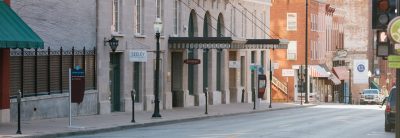Area Guide
Nestled in the heart of the city, Hotel Julien Dubuque is your perfect home base to discover all that this vibrant area has to offer. Explore the neighborhood—view the interactive map below to discover nearby attractions and landmarks.
Things To Do
From scenic riverfront views to vibrant local events, there's always something to discover in Dubuque. Whether you're exploring historic landmarks, enjoying live music, or tasting your way through our local food scene, our city offers something for every kind of traveler.
Looking for what's happening during your stay? Check out the Travel Dubuque Events Calendar for the latest festivals, performances, markets, and more.
Fourth Street Elevator
The Fourth Street Elevator, also known as the Fenelon Place Elevator, is a historic and uniquely charming funicular railway in downtown Dubuque, Iowa. Stretching approximately 296 feet (about 90 m), it climbs steeply—nearly 41° incline, rising 189 feet—to connect Fourth Street with Fenelon Place atop the bluff.
This quirky and historic elevator remains one of just a handful of operational funiculars in the U.S. today. Whether you're a history buff, a photographer, or just curious, a ride on the Fourth Street Elevator is a must when visiting Dubuque.
This quirky and historic elevator remains one of just a handful of operational funiculars in the U.S. today. Whether you're a history buff, a photographer, or just curious, a ride on the Fourth Street Elevator is a must when visiting Dubuque.

Julien Dubuque Monument
Situated on a bluff overlooking the Mississippi River and Catfish Creek, the monument offers panoramic views of Dubuque and beyond. It's within the 1,439-acre Mines of Spain State Recreation Area, recognized as a National Historic Landmark District for its archaeological sites tied to Meskwaki lead mining and early European settlement.
The park includes trails, interpretive signage, a nature center, bird and butterfly gardens, and picnic areas—ideal for history buffs and outdoor lovers alike.
The park includes trails, interpretive signage, a nature center, bird and butterfly gardens, and picnic areas—ideal for history buffs and outdoor lovers alike.

Grand Opera House
Built in 1890, the Grand Opera House was designed by architect Willoughby James Edbrooke in the striking Richardsonian Romanesque style, featuring red sandstone, brick facade, arched windows, and heavy masonry—characteristic of the era.
The Grand Opera House hosts musicals, concerts, comedy acts, ballet, drama, and touring shows year-round. To see what’s coming up next, visit their website: https://thegrandoperahouse.com/
The Grand Opera House hosts musicals, concerts, comedy acts, ballet, drama, and touring shows year-round. To see what’s coming up next, visit their website: https://thegrandoperahouse.com/



